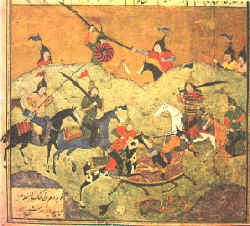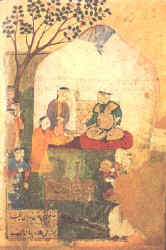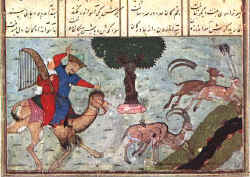Turkestan - the capital of the Kazakh Khanship
In the XVI-XVIII centuries Turkestan was the capital of the Kazakh Khanship. Kazakh Khans understood the geopilitical and spiritual importance of this town for unification of nomadic tribes included into the composition of the young state formation.
 Turkestan and his majestic monument are connected with the idea of the Kazakh state system. This role of Turkestan is emphasized by the fact that such a significant and revered place in the course of time was turned into the pantheon of outstanding statesmen, famous scientists and poets. Such prominent historic persons as Abulkhair, Rabiga Sultan-begim, Zholbarys-khan, Esim-khan, Ondan-sultan (the son of Shygai-khan), Abylai-khan, Kaz dauysty Kazbek-bi and many others were buried inside this complex.
Turkestan and his majestic monument are connected with the idea of the Kazakh state system. This role of Turkestan is emphasized by the fact that such a significant and revered place in the course of time was turned into the pantheon of outstanding statesmen, famous scientists and poets. Such prominent historic persons as Abulkhair, Rabiga Sultan-begim, Zholbarys-khan, Esim-khan, Ondan-sultan (the son of Shygai-khan), Abylai-khan, Kaz dauysty Kazbek-bi and many others were buried inside this complex.
After adjourning of the whole territory of the Middle Syr Darya to the Kazakh Khanship the town of Yasy - Turkestan, became the residence of the Kazakh khans. To that time this town turned into the largest trade and handicraft centre. Makhmud ibn Vali, the author of "Bakhr al-asrar" informed about one more name of the town: "Now Turkestan - is the town of Saksi, that is named by ordinary people as Yasy. Ahmed Ata Yasawi was born in this place and buried there." In the same source there is also the indication about the location of Esim-khan settlement in Turkestan, that was confirmed by Abulgazi who enjoyed the hospitality of Esim-khan during the years of disturbances in his motherland.
 Before the main portal of the Ahmed Ata Yasawi complex a special mausoleum was built for Esim-khan. At this cemetery there was the mausoleum of Ondan-sultan, the other son of Shygai-khan, mentioned by Kadyralibek in "Jami at-tavarikh". But this mausoleum was destroyed and do not exist now. However, the grave-stone of Amanbike is consdered to be the earliest monument related to the governing clan of the Kazakhs in Turkestan. Judging from the epitaph she was the daughter of Janibek, the founder of the Kazakh Khanship, and died in 925 according to the Muslem calendar-khizhdra ( i.e. in 1519).
Before the main portal of the Ahmed Ata Yasawi complex a special mausoleum was built for Esim-khan. At this cemetery there was the mausoleum of Ondan-sultan, the other son of Shygai-khan, mentioned by Kadyralibek in "Jami at-tavarikh". But this mausoleum was destroyed and do not exist now. However, the grave-stone of Amanbike is consdered to be the earliest monument related to the governing clan of the Kazakhs in Turkestan. Judging from the epitaph she was the daughter of Janibek, the founder of the Kazakh Khanship, and died in 925 according to the Muslem calendar-khizhdra ( i.e. in 1519).
The Embassies from the neighbouring states were sent to Turkestan, to the Kazakh khans. The record of the Russian Embassy to Tauke khan arrived to Turkestan on July 22, 1694 survived almost in full. Turkestan was not only the quarters of the Kazakh rulers. Here the meetings of the higher Kazakh nobility were held to solve the most important state-related matters. Later holding of meetings of the higher nobility in Turkestan was documented.
In Turkestan there were ceremonies of elevation of the Kazakh khans to the throne. Thus, in 1737 sultan Abulmambet was elected as khan. According to the message of Janibek batyr, Abulmambet , "the son of the former Pulat-khan was the last year elected in Turkestan as khan by the noblest Kyrghyz-Kaisak clans such as Argyn, Aktai, Uvaktirey and others... " The messages about the ceremonial election of Abylai as khan are more detailed and in general provide a clear picture of the historic ceremony. According to the record of captain Brekhov, Abylai "was honoured of the khan title in the previous 1771 in the time of pursuing of the Volga kalmyks escaped from areas that were under the authority of Her Imperial Majesty. This title was given to him in Turkestan near the grave of the sacred Ahmed Ata by the khans of three Hordes, sultans, Kyrghyz leaders, and also by the best representatives of Tashkent and Turkestan towns for him to be the sultan superior to all khans . Then according to their customs, as all former khans had been elevated to the throne, the approving prayer was read and he was elevated to the throne by lifting on the white felt mat before the whole meeting".
in the time of pursuing of the Volga kalmyks escaped from areas that were under the authority of Her Imperial Majesty. This title was given to him in Turkestan near the grave of the sacred Ahmed Ata by the khans of three Hordes, sultans, Kyrghyz leaders, and also by the best representatives of Tashkent and Turkestan towns for him to be the sultan superior to all khans . Then according to their customs, as all former khans had been elevated to the throne, the approving prayer was read and he was elevated to the throne by lifting on the white felt mat before the whole meeting".
It is known that in other places of Kazakhstan the all-kazakh kurultais (meetings) were also held (for example, in Ordabasy). However, as the historic facts testify, only in Turkestan the meetings of the national level were held on the regular basis. Not by chance namely Turkestan was chosen as the political centre of the Kazakh khanship. This town was the second Mecca for the Muslems of Central Asia, it was situated on the border of the nomadic and settled cultures, on the juncture of trade roads, it had powerful fortifications.



